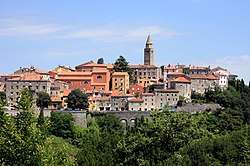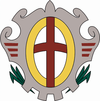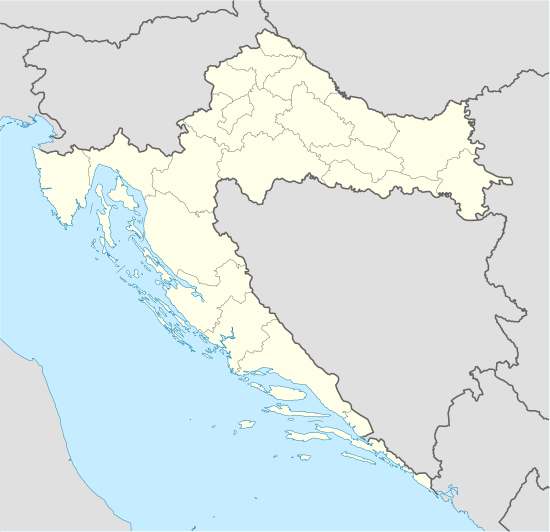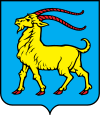Labin
Labin (Italian: Albona) is a town in Istria, Croatia, with a town population of 6,893 (2011) and 11,642 in the greater municipality (which also includes the small towns of Rabac and Vinež, as well as a number of smaller villages).[1]
Labin Albona | |
|---|---|
| Grad Labin Town of Labin | |
 Labin Old Town | |
 Flag  Coat of arms | |
 Labin Location of Labin within Croatia | |
| Coordinates: 45°05′N 14°07′E | |
| Country | |
| County | |
| Government | |
| • Mayor | Valter Glavičić (IDS) |
| • City Council | 17 members
|
| Area | |
| • Town | 72 km2 (28 sq mi) |
| Elevation | 230 m (750 ft) |
| Population (2011) | |
| • Town | 11,642 |
| • Density | 160/km2 (420/sq mi) |
| • Urban | 6,893 |
| Time zone | UTC+1 (CET) |
| • Summer (DST) | UTC+2 (CEST) |
| Postal code | 52220 |
| Area code(s) | 052 |
| Website | www |
History
Labin developed from the site of the Roman settlement of Albona. Its name predates classical antiquity and is derived from Proto-Indo-European *alb- ("eminence", "hill").[2] Before and under the Roman occupation, Albona was an important commune. On a marble tablet the Roman inscription we read that under the Emperor Marco Iulio Severo Filippo noble Caesar noble Prince made Albona a Republic. To be a republic it had to have two joined Magistrates called Duumviri and Public officers called Aediles which took care of Public buildings and other official duties.[3]
From 1295 it was under the rule of the dukes of Pazin, and from 1381 it found itself under the jurisdiction of the Patriarchate of Aquileia. From 1420 until 1797 it was ruled from Venice and after that belonged to Austria. Labin, as a Croatian-speaking town, was for a long time the centre of Croatia's largest coal mining district, with four mines operating at the height of its production. In March and April 1921, the town was the scene of a miners' strike which quickly grew into an anti-fascist rebellion, considered to be the first of its kind, and the declaration of the short-lived Labin Republic (also known as the Albona Republic).[4] The mine in downtown Labin closed in the 1989. The large, coal-fired power plant in nearby Fianona now has its coal imported from outside sources once the mines were closed.
The famous Lutheran reformer Matthias Flacius Illyricus (3 March 1520 – 11 March 1575), was born in Albona and a small exhibition in what was once his house, commemorates this. Unfortunately, due to the counter-reformation, he was forced to live most of his life in exile in Germany where he became the undisputed leader of the conservative wing of the Lutheran movement after the death of Luther. His chief literary legacy was in the area of biblical exegesis.
Demography
| Year | Pop. | ±% |
|---|---|---|
| 1880 | 3,722 | — |
| 1890 | 4,231 | +13.7% |
| 1900 | 4,369 | +3.3% |
| 1910 | 4,564 | +4.5% |
| 1921 | 4,495 | −1.5% |
| 1931 | 3,531 | −21.4% |
| 1948 | 7,958 | +125.4% |
| 1953 | 9,851 | +23.8% |
| 1961 | 10,253 | +4.1% |
| 1971 | 10,778 | +5.1% |
| 1981 | 12,014 | +11.5% |
| 1991 | 13,144 | +9.4% |
| 2001 | 12,426 | −5.5% |
| 2011 | 11,642 | −6.3% |
| Source: Naselja i stanovništvo Republike Hrvatske 1857–2001, DZS, Zagreb, 2005 | ||
See also
- Albona Republic
- Labinština
- Brovinje
- Koromačno
- Cerovica (Istria)
- Marceljani
- Skitača
- Sv Lovreč Labinski
References
- "Population by Age and Sex, by Settlements, 2011 Census: Labin". Census of Population, Households and Dwellings 2011. Zagreb: Croatian Bureau of Statistics. December 2012.
- Šimunović 2013, pp. 167–168.
- Labin, Yugoslavia (1870). Societa del Gabinetto di Minerva (ed.). Statuto municipale della città di Albona dell'a. 1341 (in Italian). Trieste: Società del Gabinetto di Minerva. pp. III–XVI. Retrieved 19 December 2013.
- G. Scotti - L. Giuricin. La Repubblica di Albona e il movimento dell'occupazione delle fabbriche in Italia
Sources
- Šimunović, Petar (March 2013). "Predantički toponimi u današnjoj (i povijesnoj) Hrvatskoj" [Pre-Roman placenames in present-day (and historical) Croatia] (PDF). Folia Onomastica Croatica (in Croatian). Zagreb: Croatian Academy of Sciences and Arts (22): 147–214. Retrieved 18 January 2016.CS1 maint: ref=harv (link)
External links
| Wikimedia Commons has media related to Labin. |
- Official website (in Croatian)
- Labin.com is the first site about Labin (in Croatian)
- Labin.biz - search engine for small businesses registered in Labin (in Croatian)
